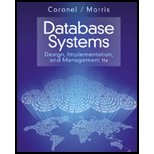
(a)
UNION set operator:
The UNION set operator is used to combine the output of two or more than two queries and produce a result. The produced result contains unique values.
Syntax:
QUERY UNION QUERY;
Consider two tables:
Table creation:
CREATE TABLE VENDOR(VEND_CODE INT PRIMARY KEY);
CREATE TABLE PRODUCT(PROD_CODE VARCHAR(5), VEND_CODE INT,FOREIGN KEY (VEND_CODE) REFERENCES VENDOR (VEND_CODE));
Inserting values:
INSERT INTO VENDOR VALUES(123);
INSERT INTO VENDOR VALUES(124);
INSERT INTO VENDOR VALUES(125);
INSERT INTO VENDOR VALUES(126);
INSERT INTO PRODUCT VALUES('ABC', 125);
INSERT INTO PRODUCT VALUES('DEF', 124);
INSERT INTO PRODUCT VALUES('GHI', 124);
INSERT INTO PRODUCT VALUES('JKL', 123);
(b)
UNION ALL set operator:
The UNION ALL set operator is used to combine the output of two or more than two queries and produce a result. The produced result contains duplicate values.
Syntax:
QUERY UNION ALL QUERY;
Consider two tables:
Table creation:
CREATE TABLE VENDOR(VEND_CODE INT PRIMARY KEY);
CREATE TABLE PRODUCT(PROD_CODE VARCHAR(5), VEND_CODE INT,FOREIGN KEY (VEND_CODE) REFERENCES VENDOR (VEND_CODE));
Inserting values:
INSERT INTO VENDOR VALUES(123);
INSERT INTO VENDOR VALUES(124);
INSERT INTO VENDOR VALUES(125);
INSERT INTO VENDOR VALUES(126);
INSERT INTO PRODUCT VALUES('ABC', 125);
INSERT INTO PRODUCT VALUES('DEF', 124);
INSERT INTO PRODUCT VALUES('GHI', 124);
INSERT INTO PRODUCT VALUES('JKL', 123);
(c)
INTERSECT set operator:
The INTERSECT set operator is used to combine the output of two or more than two queries and produce a result. The produced result contains the values (rows) that are common in both the tables.
Syntax:
QUERY INTERSECT QUERY;
Consider two tables:
Table creation:
CREATE TABLE VENDOR(VEND_CODE INT PRIMARY KEY);
CREATE TABLE PRODUCT(PROD_CODE VARCHAR(5), VEND_CODE INT,FOREIGN KEY (VEND_CODE) REFERENCES VENDOR (VEND_CODE));
Inserting values:
INSERT INTO VENDOR VALUES(123);
INSERT INTO VENDOR VALUES(124);
INSERT INTO VENDOR VALUES(125);
INSERT INTO VENDOR VALUES(126);
INSERT INTO PRODUCT VALUES('ABC', 125);
INSERT INTO PRODUCT VALUES('DEF', 124);
INSERT INTO PRODUCT VALUES('GHI', 124);
INSERT INTO PRODUCT VALUES('JKL', 123);
(d)
EXCEPT/ MINUS set operator:
The MINUS set operator is used to combine the output of two or more than two queries and produce a result. The produced result contains the values (rows) that appear in the first table but not in the second table. The word “EXCEPT” can also be used in the place of “MINUS”.
Syntax:
QUERY EXCEPT QUERY;
Consider two tables:
Table creation:
CREATE TABLE VENDOR(VEND_CODE INT PRIMARY KEY);
CREATE TABLE PRODUCT(PROD_CODE VARCHAR(5), VEND_CODE INT,FOREIGN KEY (VEND_CODE) REFERENCES VENDOR (VEND_CODE));
Inserting values:
INSERT INTO VENDOR VALUES(123);
INSERT INTO VENDOR VALUES(124);
INSERT INTO VENDOR VALUES(125);
INSERT INTO VENDOR VALUES(126);
INSERT INTO PRODUCT VALUES('ABC', 125);
INSERT INTO PRODUCT VALUES('DEF', 124);
INSERT INTO PRODUCT VALUES('GHI', 124);
INSERT INTO PRODUCT VALUES('JKL', 123);
Trending nowThis is a popular solution!

Chapter 8 Solutions
Database Systems: Design, Implementation, & Management
 Database Systems: Design, Implementation, & Manag...Computer ScienceISBN:9781305627482Author:Carlos Coronel, Steven MorrisPublisher:Cengage Learning
Database Systems: Design, Implementation, & Manag...Computer ScienceISBN:9781305627482Author:Carlos Coronel, Steven MorrisPublisher:Cengage Learning Database Systems: Design, Implementation, & Manag...Computer ScienceISBN:9781285196145Author:Steven, Steven Morris, Carlos Coronel, Carlos, Coronel, Carlos; Morris, Carlos Coronel and Steven Morris, Carlos Coronel; Steven Morris, Steven Morris; Carlos CoronelPublisher:Cengage LearningNp Ms Office 365/Excel 2016 I NtermedComputer ScienceISBN:9781337508841Author:CareyPublisher:Cengage
Database Systems: Design, Implementation, & Manag...Computer ScienceISBN:9781285196145Author:Steven, Steven Morris, Carlos Coronel, Carlos, Coronel, Carlos; Morris, Carlos Coronel and Steven Morris, Carlos Coronel; Steven Morris, Steven Morris; Carlos CoronelPublisher:Cengage LearningNp Ms Office 365/Excel 2016 I NtermedComputer ScienceISBN:9781337508841Author:CareyPublisher:Cengage
 A Guide to SQLComputer ScienceISBN:9781111527273Author:Philip J. PrattPublisher:Course Technology Ptr
A Guide to SQLComputer ScienceISBN:9781111527273Author:Philip J. PrattPublisher:Course Technology Ptr





